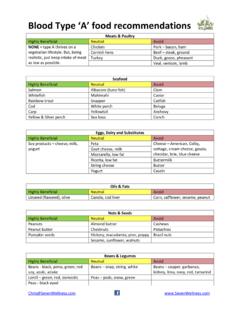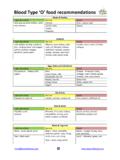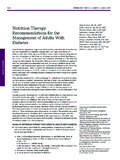Transcription of WORLD HEALTH ORGANIZATION ORGANISATION …
1 Preparation of reference standards final draft. Adopted by the 55th meeting of the WHO Expert Committee on Biological Standardization, 15-18 November 2004. A definitive version of this document, which will differ in editorial detail but not scientific content, will be published in the WHO Technical Report Series 1 2 3 4 5 RECOMMENDATIONS FOR THE PREPARATION, 6 CHARACTERIZATION AND ESTABLISHMENT OF 7 INTERNATIONAL AND OTHER BIOLOGICAL REFERENCE 8 STANDARDS 9 10 (Revised 2004) 11 12 13 14 15 ./.. 16 17 18 19 20 21 22 23 24 25 26 WORLD HEALTH ORGANIZATION ORGANISATION MONDIALE DE LA SANTE Preparation of reference standards final draft.
2 Adopted by the 55th meeting of the WHO Expert Committee on Biological Standardization, 15-18 November 2004. A definitive version of this document, which will differ in editorial detail but not scientific content, will be published in the WHO Technical Report Series Page 2 Introduction 27 28 General considerations 29 30 Part A. Recommendations for the preparation, characterization and establishment of 31 international biological reference standards 32 1. Introduction 33 2. Quality assurance 34 3. Assessment of need and procurement of materials 35 4. Distribution into final containers 36 5.
3 Processing of filled ampoules 37 6. International collaborative studies 38 7. Detailed information to be provided to WHO 39 8. Establishment of an international biological reference standard 40 41 Part B. General considerations for the preparation, characterization and calibration of regional 42 or national biological reference standards 43 1. Introduction 44 2. Assessment of need and procurement of material 45 3. Distribution into and processing of final containers 46 4. Calibration 47 48 Acknowledgements 49 50 References 51 52 Appendix 1: Considerations for setting priorities in developing WHO International 53 Biological Measurement Standards or WHO Reference Reagents 54 55 Appendix 2.
4 Information to be included in instruction leaflets and safety data sheets for 56 users of international or other biological reference standards 57 58 59 INTRODUCTION 60 61 A core function of WHO, set out in its Constitution (Article 2), is to "develop, establish 62 and promote international standards with respect to food, biological, pharmaceutical and 63 similar products" as well as "to standardize diagnostic procedures as necessary". This 64 responsibility is discharged in part by establishment of biological reference standards that 65 form the basis of regulation and clinical dosing for biological medicines and also for 66 regulation of in vitro diagnostic devices.
5 The process whereby such international biological 67 reference standards are established and the technical specifications to which they comply are 68 set out in this guidance document, which is intended to be scientific and advisory in nature. 69 70 Preparation of reference standards final draft. Adopted by the 55th meeting of the WHO Expert Committee on Biological Standardization, 15-18 November 2004. A definitive version of this document, which will differ in editorial detail but not scientific content, will be published in the WHO Technical Report Series Page 3 71 The provision of international biological reference standards makes a critically 72 important contribution to recurring high standards of efficacy, quality, purity and safety of 73 very many biological medicines used worldwide in the prevention, treatment or diagnosis of 74 disease or conditions.
6 Their use supports the application of the many biological and 75 immunological assays used in the standardization and control of a wide range of biologicals 76 including therapeutics, blood-derived products, vaccines and immunological products of 77 traditional types as well as those derived from modern biotechnological approaches. They 78 also have important applications in the standardization of materials and approaches used in 79 medical diagnostics such as diagnosing disease, monitoring therapy, blood safety, and public 80 HEALTH applications (eg. monitoring immune status, screening for disease or susceptibility) or 81 otherwise characterizing biological material from individuals.
7 82 83 84 WHO biological reference standards are widely used in the development, evaluation, 85 standardization and control of products in industry, by regulatory authorities and also in 86 biological research in academia and scientific organizations. They play a vital role in 87 facilitating the transfer of laboratory science into worldwide clinical practice and the 88 development of safe and effective biologicals. 89 90 There are special considerations and challenges which apply to the production and 91 quality evaluation of biologicals, including the inherent variability of biological systems, 92 variability of biological and immunological assays, and the potential for microbial 93 contamination.
8 The availability of WHO reference standards has made a major contribution 94 to progress in the development and use of biologicals and in addressing these challenges. 95 96 In particular the reference standards have an essential role in the development of 97 internationally agreed systems for measurement of biological and immunological activities 98 residing in biological products. There is a wide variety of potential types of measurements: 99 for example biological activity, immunological activity, quantity, biotypes and genetic types. 100 In addition, for each measurement type, there are numerous variations of methodologies and 101 reagents.
9 Therefore, the purpose of the reference standards is to facilitate standardized 102 characterization of biological samples, no matter what type of measurement or method is 103 Preparation of reference standards final draft. Adopted by the 55th meeting of the WHO Expert Committee on Biological Standardization, 15-18 November 2004. A definitive version of this document, which will differ in editorial detail but not scientific content, will be published in the WHO Technical Report Series Page 4 used. Many WHO biological reference standards are designated as International Standards 104 (IS) and provide the unique physical basis for the definition of International Units (IUs) of 105 biological and/or immunological activity.
10 Their use enables the achievement of consistency 106 in the measurement of key attributes of biologicals, for example biological potency or 107 immunological activity and, thus, the development of internationally agreed criteria for 108 acceptability and standardization and control of products. It also provides the basis for the 109 comparability of data from different sources in relation to specific products. Assays for 110 markers of immunity ( to infectious agents) are often defined in terms of agreed IUs of 111 antibodies, providing a basis for an international consensus on the measurement of the 112 immunological status of individuals or populations following vaccination or infection.














